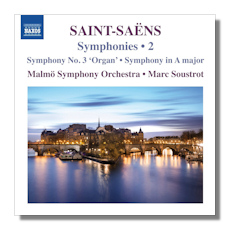
The Internet's Premier Classical Music Source
Related Links
- Saint-Saëns Reviews
- Latest Reviews
- More Reviews
-
By Composer
-
Collections
DVD & Blu-ray
Books
Concert Reviews
Articles/Interviews
Software
Audio
Search Amazon
Recommended Links
Site News
 CD Review
CD Review
Camille Saint-Saëns

Symphonies, Volume 2
- Symphony #3 in C minor "Organ", Op. 78 *
- Symphony in A Major
- Le rouet d'Omphale, Op. 31
* Carl Adam Landström, organ
Malmö Symphony Orchestra/Marc Soustrot
Naxos 8.573139 71:40
Also available Volume 1 on Naxos 8.573138:
Amazon
- UK
- Germany
- Canada
- France
- Japan
- ArkivMusic
- CD Universe
- JPC
This is the second and final volume in Marc Soustrot's cycle of the symphonies of Camille Saint-Saëns. It is also the second Naxos CD within several months containing a performance of Saint-Saëns' Symphony #3, the earlier one being the Slatkin/Detroit version. It is very thoughtful of the label to give us an alternative choice so soon, and in this case such an excellent one. I reviewed the Slatkin performance of the Saint-Saëns Third in March (Naxos 8.573331) and found it quite impressive. In fact, it has been widely acclaimed internationally, and I should mention that colleague Brian Wigman also gave it a positive review here in April (Naxos 8.573331). But this new effort by Marc Soustrot is just as convincing, despite taking a rather different approach to this work. Where Slatkin and his Detroit players are very precise and a bit less lush in the big lyrical moments, Soustrot and the Malmö Symphony Orchestra are somewhat more dramatic and revel in the lushness of the poco Adagio theme, taking it much slower. But the faster sections are generally played with a tad more animation and energy by Soustrot, which also gives the music a greater sense of contrast. Both organists are quite fine, and so depending on your view of the work you could select either one of these as a first choice in the Symphony #3.
Granted, there are classic recordings by Toscanini, Prêtre and others, but their less vivid sound handicaps them somewhat. I'd prefer to stick with either Slatkin or Soustrot, despite a few notable recent recordings by Yannick Nézet-Séguin and Claus Peter Flor, as their discs mix in repertory by other composers. So the choice between Slatkin and Soustrot is a tough one, essentially a toss-up, not least because the sound reproduction and balances are also first-rate in both. But to help make the choice a bit more manageable, one must look at the companion works on the respective discs.
The Slatkin contains two organ works, one an arrangement for solo organ of the Danse Macabre and the other a short work for organ and orchestra of limited interest. The Soustrot offers the early Symphony in A major (c. 1850), composed when Saint-Saëns was around fifteen years old, and the short symphonic poem Le rouet d'Omphale. The symphony clearly shows the influence of Mozart, not least in its first movement references to music in the finale of Mozart's Symphony #41 ("Jupiter"). There are also stylistic hints of Beethoven, Schubert and Mendelssohn, but very little of the mature style of Saint-Saëns. It's a charming work from the young composer though, who was, like Mozart, a child prodigy. Soustrot and the Malmö players deliver a spirited and well played performance of this rarely recorded work.
Le rouet d'Omphale is a more consequential offering, even though it is brief (8:19) and rather light. Indeed, it is a delightful work whose rhythmically bouncy opening theme has a vague resemblance to the famous one in Ponchielli's Dance of the Hours. Overall, this choice Saint-Saëns morsel is quite thematically attractive and colorfully orchestrated, making it a very worthwhile filler. Again, Soustrot draws a splendid performance from the orchestra, yielding such effervescence, subtlety and charm as to make you wish Saint-Saëns had gone on longer with this work.
Now, back to choosing between the two versions… With the Soustrot CD you get 71:40 vs 57:45 for Slatkin. Unless you're an organ aficionado, the scales tilt in favor of this slightly newer disc by Soustrot.
Copyright © 2015, Robert Cummings





















